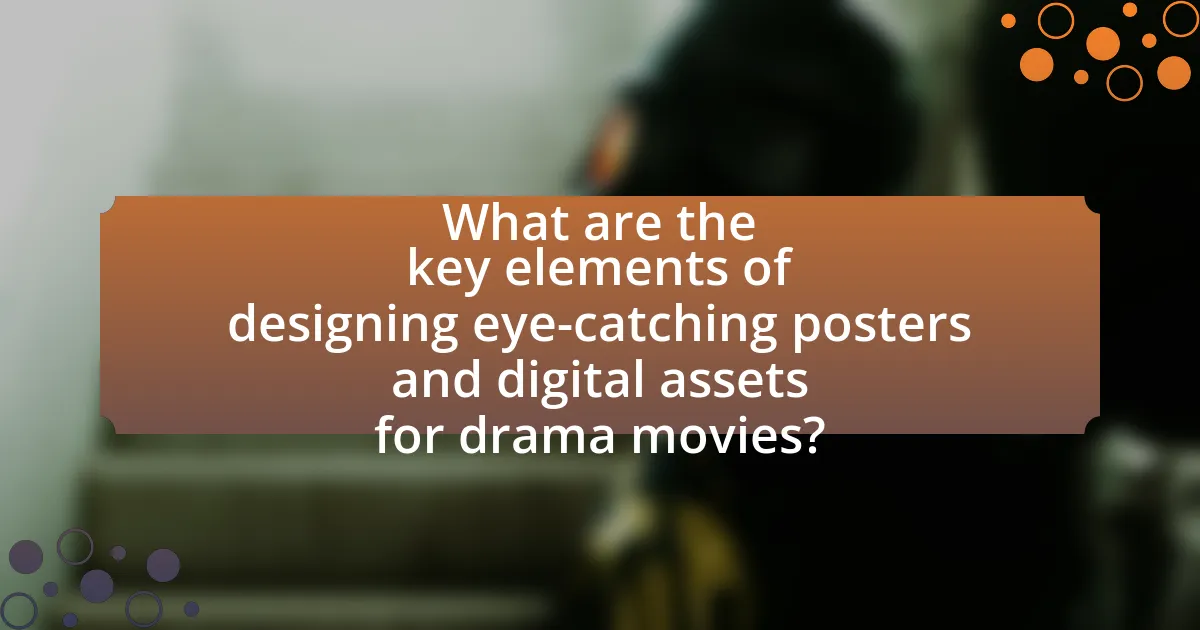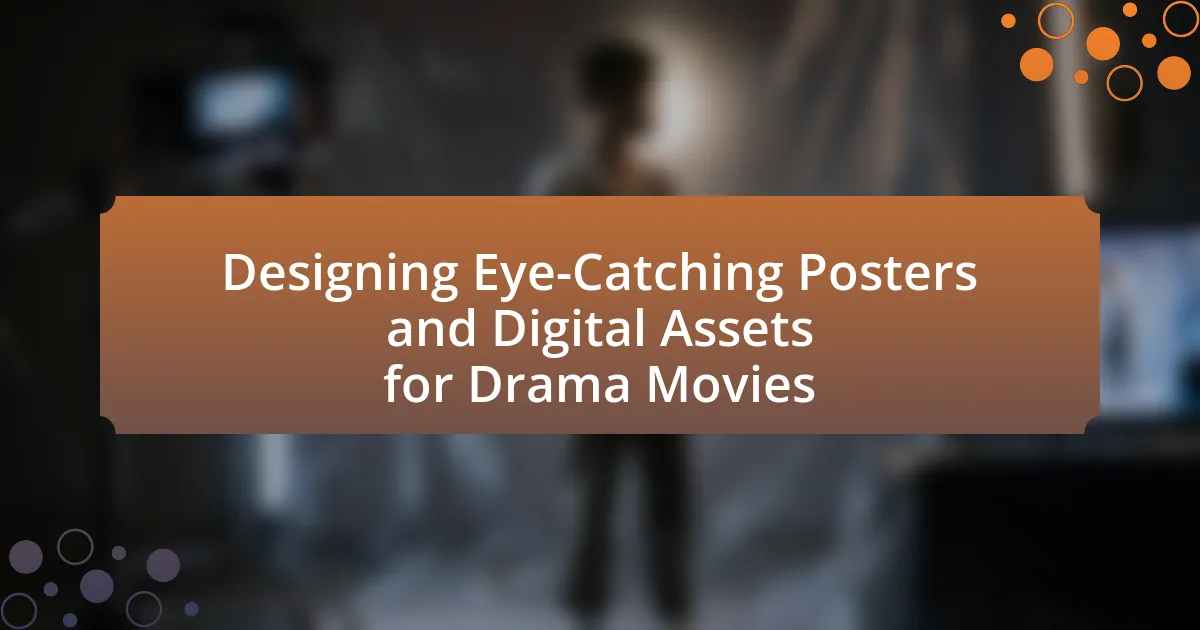The article focuses on the essential elements of designing eye-catching posters and digital assets for drama movies, emphasizing the importance of compelling imagery, effective typography, and a strong color palette. It explores how color schemes influence audience perception and emotional responses, detailing the psychological impact of different colors and the role of contrast in enhancing visual appeal. Additionally, the article discusses the significance of typography in conveying the film’s tone, the effectiveness of various font styles, and the impact of font size on readability. It also highlights the importance of imagery in representing the movie’s themes and emotions, as well as best practices for creating cohesive digital assets that resonate with target audiences.

What are the key elements of designing eye-catching posters and digital assets for drama movies?
The key elements of designing eye-catching posters and digital assets for drama movies include compelling imagery, effective typography, and a strong color palette. Compelling imagery captures the emotional essence of the film, often featuring key characters or pivotal scenes that resonate with the audience. Effective typography enhances readability and conveys the film’s tone, with font choices that reflect the drama’s themes. A strong color palette creates visual impact and evokes specific emotions, aligning with the narrative’s mood. These elements work together to attract attention and communicate the film’s essence, as evidenced by successful drama movie posters that utilize these principles to engage viewers and generate interest.
How do color schemes influence the perception of drama movie posters?
Color schemes significantly influence the perception of drama movie posters by evoking specific emotions and setting the tone for the film. For instance, warm colors like red and orange can create feelings of passion or tension, while cooler colors such as blue and green often convey calmness or sadness. Research indicates that color psychology plays a crucial role in how audiences interpret visual stimuli; for example, a study published in the Journal of Consumer Research found that colors can affect emotional responses and decision-making processes. Therefore, the strategic use of color in drama movie posters not only attracts attention but also communicates the underlying themes and emotional depth of the film, guiding viewer expectations effectively.
What emotions do different colors evoke in viewers?
Different colors evoke specific emotions in viewers, influencing their perceptions and reactions. For instance, red typically evokes feelings of passion, excitement, and urgency, often used in drama to convey intensity. Blue tends to evoke calmness, trust, and serenity, making it suitable for conveying stability in dramatic narratives. Yellow is associated with happiness and optimism, while green often represents nature and tranquility, which can provide a sense of balance in dramatic themes. Additionally, purple is linked to luxury and creativity, enhancing the emotional depth of a drama. These associations are supported by psychological studies, such as those conducted by the Institute for Color Research, which found that color can significantly affect mood and behavior, confirming the emotional impact of colors in visual design.
How can color contrast enhance visual appeal?
Color contrast enhances visual appeal by creating a dynamic interplay between different hues, making elements stand out and capturing viewer attention. High contrast between colors, such as pairing dark shades with bright ones, increases readability and draws focus to key components, which is essential in designing posters and digital assets for drama movies. Research indicates that effective color contrast can improve viewer engagement by up to 80%, as it helps convey emotions and themes more vividly, thereby enhancing the overall aesthetic experience.
What role does typography play in poster design?
Typography plays a crucial role in poster design by conveying the message and tone of the content effectively. It influences the viewer’s perception and emotional response, guiding them to understand the theme and mood of the drama movie being promoted. For instance, bold and dramatic fonts can evoke excitement and urgency, while softer, elegant typefaces may suggest romance or introspection. Research indicates that 95% of first impressions are based on visual appearance, including typography, highlighting its importance in capturing attention and communicating the intended message.
Which font styles are most effective for drama movie themes?
Serif fonts are most effective for drama movie themes due to their classic and elegant appearance, which conveys a sense of seriousness and depth. Fonts like Times New Roman, Garamond, and Baskerville are commonly used in drama film posters because they evoke a traditional and sophisticated feel, aligning with the emotional weight often present in dramatic narratives. Research indicates that serif fonts enhance readability and create a more formal tone, making them suitable for conveying the gravity of drama films.
How does font size impact readability and viewer engagement?
Font size significantly impacts readability and viewer engagement by influencing how easily text can be read and understood. Larger font sizes enhance readability, making it easier for viewers to quickly grasp information, which is crucial in capturing attention in a competitive visual landscape. Research indicates that text displayed in a size of 12 points or larger is generally more legible, particularly for audiences with varying visual abilities. Additionally, studies show that optimal font sizes can increase viewer retention and engagement; for instance, a study published in the Journal of Vision found that larger text sizes lead to better recall of information. Therefore, appropriate font sizing is essential in designing effective posters and digital assets for drama movies, as it directly affects how well the audience engages with the content.
Why is imagery crucial in drama movie posters?
Imagery is crucial in drama movie posters because it visually conveys the emotional tone and themes of the film, attracting potential viewers. Effective imagery can encapsulate complex narratives and character dynamics, allowing audiences to quickly grasp the essence of the story. For instance, a poster featuring a somber color palette and intense facial expressions can evoke feelings of tension and drama, which are central to the genre. Research indicates that visual elements significantly influence consumer behavior, with studies showing that 93% of consumers’ first impressions are based on visual appearance. This underscores the importance of compelling imagery in capturing attention and generating interest in drama films.
What types of images resonate most with drama movie audiences?
Images that resonate most with drama movie audiences typically feature intense emotional expressions, character interactions, and evocative settings. These visuals effectively convey the film’s themes and emotional depth, drawing viewers in. Research indicates that posters showcasing close-ups of characters displaying strong emotions, such as sadness or conflict, are particularly impactful, as they create an immediate connection with the audience. Additionally, images that depict pivotal moments or dramatic scenes from the film can enhance viewer interest, as they suggest a narrative that invites exploration.
How can imagery convey the movie’s tone and message?
Imagery conveys a movie’s tone and message by visually representing the emotional and thematic elements of the narrative. For instance, dark color palettes and shadowy visuals can evoke feelings of suspense or sadness, while bright colors and dynamic compositions can suggest joy or excitement. This visual language helps to set audience expectations and enhances their emotional engagement with the film. Research indicates that visual elements significantly influence viewer perception, as demonstrated in studies showing that color and composition can alter emotional responses to media content.
How can designers effectively communicate a movie’s narrative through visual assets?
Designers can effectively communicate a movie’s narrative through visual assets by utilizing imagery, color schemes, typography, and composition that reflect the film’s themes and emotions. For instance, a drama movie may use somber colors and expressive imagery to evoke feelings of tension or sadness, aligning with the narrative’s tone. Research indicates that visual elements can significantly influence audience perception; a study by Hagtvedt and Brasel (2016) found that color can affect emotional responses and brand perceptions, which can be directly applied to film marketing. By strategically combining these visual components, designers can create assets that not only attract attention but also convey the essence of the story, ensuring that potential viewers grasp the narrative’s core before even watching the film.
What storytelling techniques can be applied in poster design?
Visual hierarchy is a key storytelling technique in poster design, as it guides the viewer’s eye to the most important elements first. By strategically using size, color, and placement, designers can emphasize the title, main imagery, and tagline, creating a narrative flow that captures attention. For instance, larger text or bold colors can signify the film’s title, while imagery that evokes emotion can convey the film’s theme or mood, effectively communicating the story’s essence at a glance. This approach is supported by studies in visual communication, which indicate that viewers process visual information more quickly when a clear hierarchy is established, enhancing their understanding of the narrative being presented.
How can visual hierarchy guide viewer interpretation?
Visual hierarchy guides viewer interpretation by organizing elements in a way that directs attention and conveys meaning effectively. This organization is achieved through variations in size, color, contrast, and placement, which help viewers prioritize information. For instance, larger text typically draws more attention, signaling its importance, while contrasting colors can highlight key elements, making them stand out. Research indicates that effective visual hierarchy can enhance comprehension and retention of information, as demonstrated in studies on design principles, such as those by Tufte, which emphasize the role of visual clarity in communication.
What symbols or motifs can represent key themes in drama movies?
Symbols and motifs that represent key themes in drama movies include broken mirrors, rain, and the color red. Broken mirrors symbolize fractured identities or relationships, often reflecting the internal struggles of characters. Rain frequently represents emotional turmoil or cleansing, serving as a backdrop for pivotal moments in the narrative. The color red is commonly associated with passion, love, or danger, highlighting intense emotional states or conflicts within the story. These symbols effectively convey the underlying themes of conflict, transformation, and emotional depth that are central to drama films.
How does the target audience influence design choices?
The target audience significantly influences design choices by dictating aesthetic preferences, messaging, and emotional resonance. Designers analyze demographic data, such as age, gender, and cultural background, to tailor visual elements that appeal to specific viewer segments. For instance, a study by the American Psychological Association found that color schemes and imagery can evoke different emotional responses based on audience characteristics, leading to more effective engagement. Consequently, understanding the target audience allows designers to create posters and digital assets that not only attract attention but also align with the audience’s expectations and interests, ultimately enhancing the promotional impact of drama movies.
What demographic factors should be considered in design?
Demographic factors that should be considered in design include age, gender, cultural background, and socioeconomic status. Age influences preferences in color schemes, imagery, and messaging; for instance, younger audiences may prefer vibrant colors and modern aesthetics, while older audiences might favor classic designs. Gender can affect visual appeal and thematic elements, as different genders may respond to various styles and narratives. Cultural background is crucial, as it shapes the symbolism and imagery that resonate with specific groups; for example, certain colors or motifs may have different meanings across cultures. Socioeconomic status impacts accessibility and relatability of design elements, as designs must align with the lifestyle and values of the target audience. Understanding these factors enhances the effectiveness of posters and digital assets in engaging the intended demographic for drama movies.
How can audience preferences shape visual elements?
Audience preferences significantly shape visual elements by influencing design choices that resonate with target demographics. For instance, research indicates that color schemes, typography, and imagery are often tailored to align with the emotional and cultural expectations of the audience. A study by the American Psychological Association found that specific colors evoke distinct emotional responses; for example, blue is often associated with trust and calmness, while red can evoke excitement or urgency. This understanding allows designers to create posters and digital assets that effectively capture attention and convey the intended mood of drama movies, ultimately enhancing viewer engagement and interest.

What are the best practices for creating digital assets for drama movies?
The best practices for creating digital assets for drama movies include focusing on strong visual storytelling, ensuring high-quality imagery, and maintaining brand consistency. Strong visual storytelling captures the emotional essence of the film, which is crucial for drama genres that rely heavily on character development and narrative depth. High-quality imagery, including professional photography and graphic design, enhances the visual appeal and engages the audience effectively. Maintaining brand consistency across all digital assets, such as posters, social media graphics, and promotional materials, ensures that the film’s identity is cohesive and recognizable. These practices are supported by industry standards, which emphasize the importance of visual impact and emotional connection in marketing drama films.
How can designers ensure consistency across various digital platforms?
Designers can ensure consistency across various digital platforms by establishing a comprehensive style guide that outlines visual elements such as color palettes, typography, and imagery. This guide serves as a reference for all design projects, ensuring that each platform reflects the same brand identity. Research indicates that consistent branding can increase revenue by up to 23%, highlighting the importance of uniformity in design across different mediums. By adhering to the style guide, designers can maintain a cohesive look and feel, which enhances user recognition and engagement.
What guidelines should be followed for branding in digital assets?
Branding in digital assets should adhere to consistency, clarity, and audience engagement. Consistency involves using the same color palette, typography, and logo placement across all digital platforms to create a cohesive brand identity. Clarity ensures that the messaging is straightforward and easily understood, which is crucial for capturing the audience’s attention quickly. Audience engagement can be achieved through interactive elements and visually appealing designs that resonate with the target demographic. Research indicates that consistent branding can increase revenue by up to 23%, highlighting the importance of these guidelines in effective digital asset branding.
How can responsive design enhance user experience?
Responsive design enhances user experience by ensuring that digital assets, such as posters for drama movies, adapt seamlessly to various screen sizes and devices. This adaptability improves accessibility, allowing users to view content without distortion or the need for excessive scrolling. According to a study by Google, 61% of users are unlikely to return to a mobile site they had trouble accessing, highlighting the importance of responsive design in retaining audience engagement. By providing a consistent and visually appealing experience across platforms, responsive design fosters user satisfaction and encourages interaction with the content.
What tools and software are recommended for designing posters and digital assets?
Adobe Photoshop and Adobe Illustrator are highly recommended tools for designing posters and digital assets. These software programs provide extensive features for image editing, vector graphics, and layout design, making them ideal for creating visually appealing materials. According to a survey by Creative Bloq, 73% of graphic designers prefer Adobe products for their versatility and professional quality. Additionally, Canva offers a user-friendly interface and a variety of templates, making it suitable for those who may not have advanced design skills.
Which design software offers the best features for movie poster creation?
Adobe Photoshop offers the best features for movie poster creation. Its extensive toolkit includes advanced image editing capabilities, a wide range of filters, and customizable templates specifically designed for poster layouts. Additionally, Photoshop supports high-resolution graphics, which is essential for print quality in movie posters. The software’s integration with Adobe Creative Cloud allows for seamless collaboration and access to a vast library of assets, enhancing the design process. These features make Adobe Photoshop the industry standard for creating visually compelling movie posters.
How can online resources and templates aid in the design process?
Online resources and templates significantly enhance the design process by providing ready-made structures and visual elements that streamline creativity and efficiency. These resources allow designers to quickly access high-quality graphics, fonts, and layouts tailored for specific themes, such as drama movies, which can save time and reduce the need for extensive design skills. For instance, platforms like Canva and Adobe Spark offer customizable templates that cater to various design needs, enabling users to produce professional-looking posters and digital assets without starting from scratch. This accessibility to design tools and inspiration fosters innovation and helps maintain consistency in branding, as evidenced by the increasing use of such platforms in the film industry to create visually appealing promotional materials.
What tips can help designers create impactful drama movie posters?
Designers can create impactful drama movie posters by focusing on strong visual storytelling, utilizing bold typography, and incorporating emotional imagery. Strong visual storytelling captures the essence of the film, allowing viewers to connect with the narrative at a glance. Bold typography enhances readability and can convey the film’s tone, while emotional imagery evokes feelings that resonate with the audience. Research indicates that posters with compelling visuals and clear messaging significantly increase viewer interest, as seen in studies analyzing audience engagement with film marketing materials.
